Critical Evaluation of Health and Safety Policy in Oil and Gas Sector
VerifiedAdded on 2023/06/12
|37
|9128
|156
Report
AI Summary
This report provides a critical evaluation of health and safety policies within the oil and gas industry, highlighting the increasing demands for safety due to the industry's rapid growth and associated accident risks. It examines previous research and statistical data showcasing accident rates and fatalities, emphasizing the need for stringent rules and regulations. The report discusses the importance of health and safety policies, including their development and implementation, to create safer workplaces. It also addresses occupational health issues, highlighting the necessity of maintaining workers' physical and mental well-being. The evaluation considers Occupational Health and Safety Management Systems (OHSMS) and the role of safety symbols in hazard communication. Ultimately, the report aims to analyze the impact of these policies and identify areas for improvement within the oil and gas sector. Desklib offers a platform for students to access similar reports and study resources.
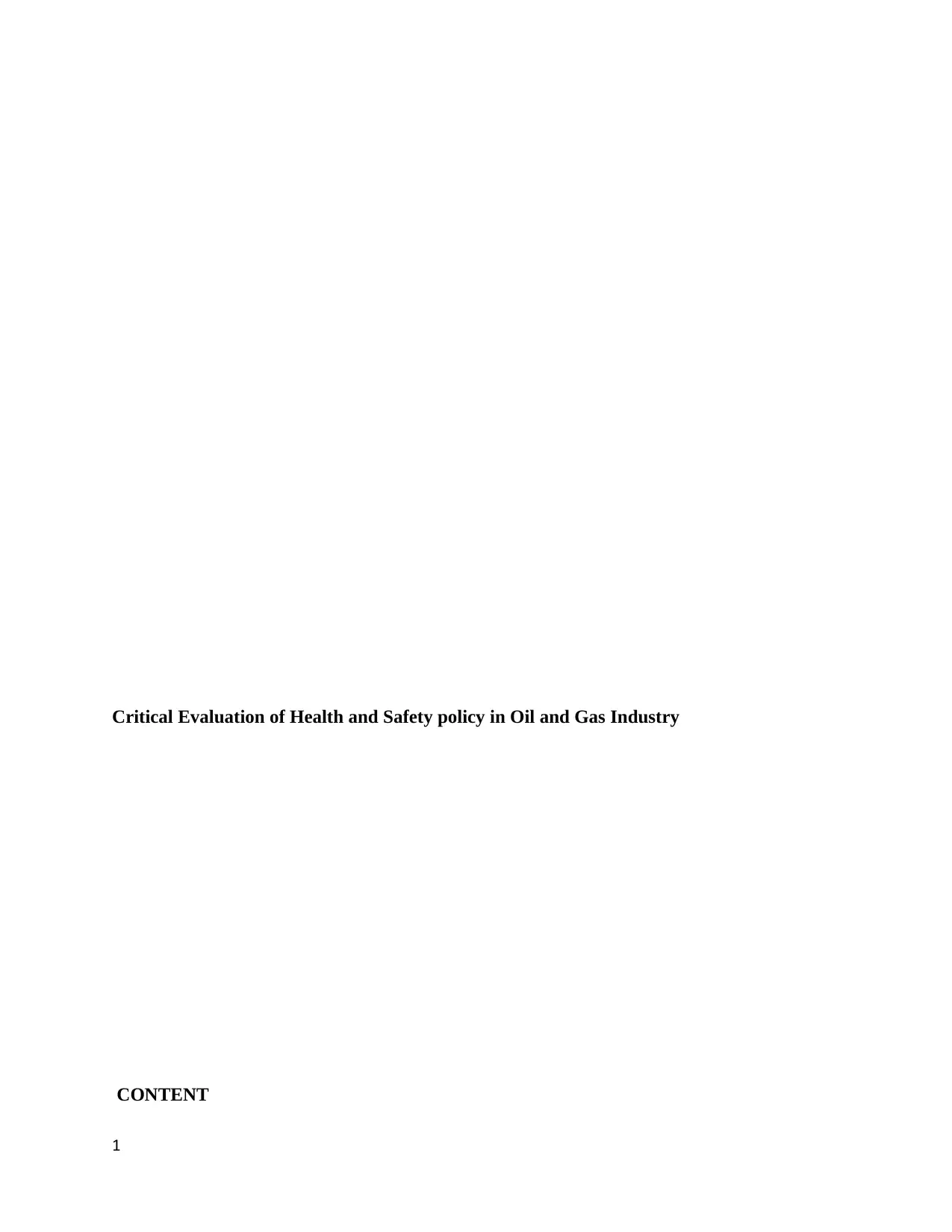
Critical Evaluation of Health and Safety policy in Oil and Gas Industry
CONTENT
1
CONTENT
1
Paraphrase This Document
Need a fresh take? Get an instant paraphrase of this document with our AI Paraphraser
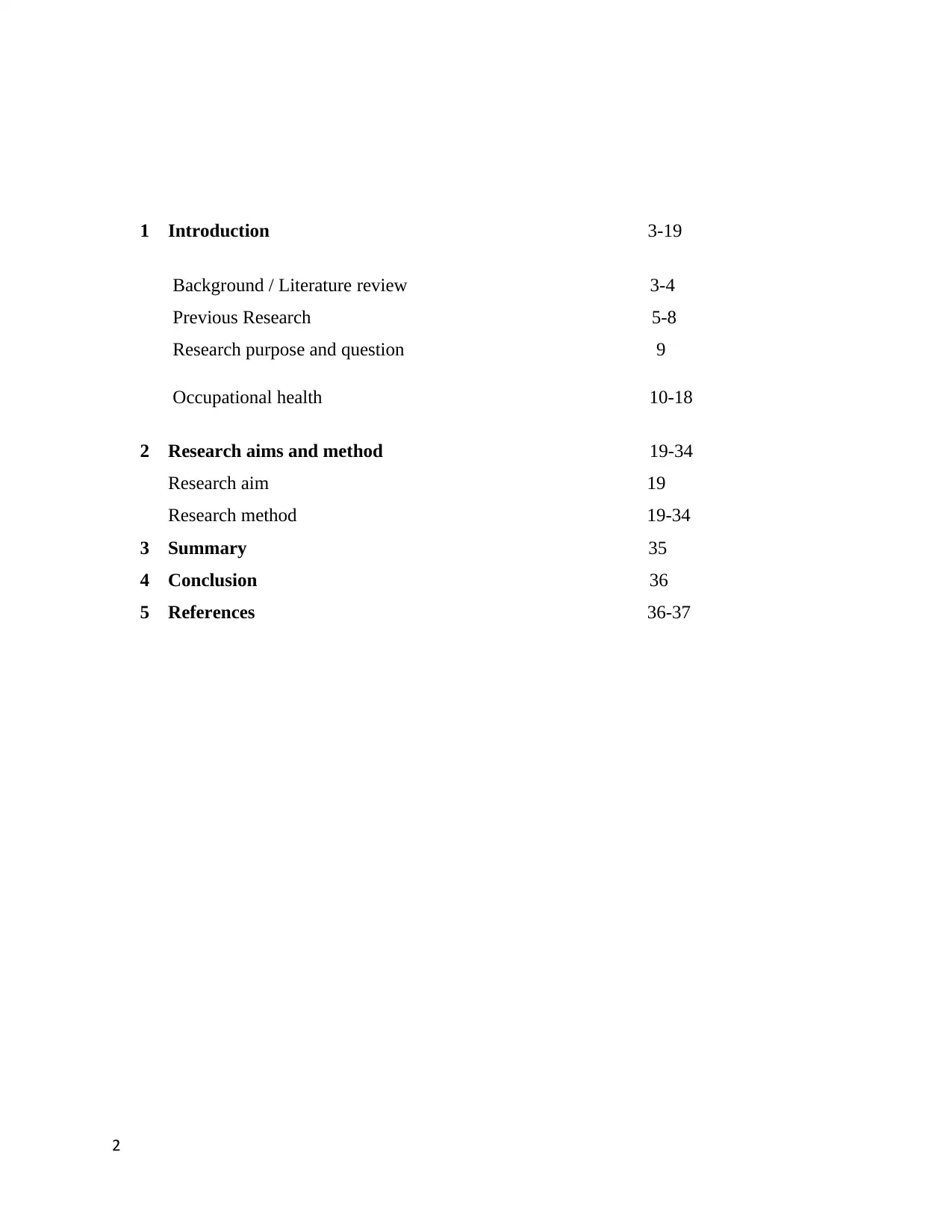
1 Introduction 3-19
Background / Literature review 3-4
Previous Research 5-8
Research purpose and question 9
Occupational health 10-18
2 Research aims and method 19-34
Research aim 19
Research method 19-34
3 Summary 35
4 Conclusion 36
5 References 36-37
2
Background / Literature review 3-4
Previous Research 5-8
Research purpose and question 9
Occupational health 10-18
2 Research aims and method 19-34
Research aim 19
Research method 19-34
3 Summary 35
4 Conclusion 36
5 References 36-37
2
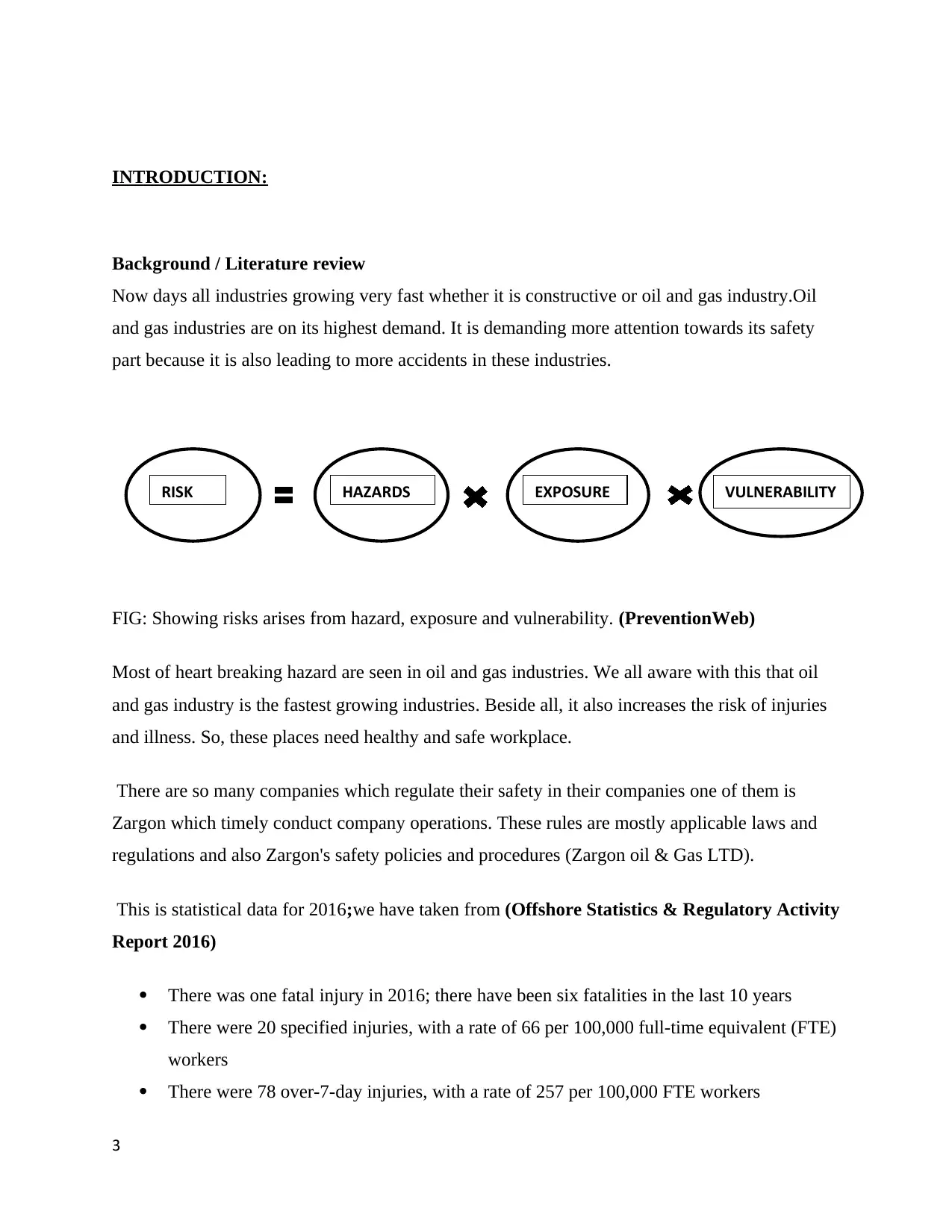
INTRODUCTION:
Background / Literature review
Now days all industries growing very fast whether it is constructive or oil and gas industry.Oil
and gas industries are on its highest demand. It is demanding more attention towards its safety
part because it is also leading to more accidents in these industries.
FIG: Showing risks arises from hazard, exposure and vulnerability. (PreventionWeb)
Most of heart breaking hazard are seen in oil and gas industries. We all aware with this that oil
and gas industry is the fastest growing industries. Beside all, it also increases the risk of injuries
and illness. So, these places need healthy and safe workplace.
There are so many companies which regulate their safety in their companies one of them is
Zargon which timely conduct company operations. These rules are mostly applicable laws and
regulations and also Zargon's safety policies and procedures (Zargon oil & Gas LTD).
This is statistical data for 2016;we have taken from (Offshore Statistics & Regulatory Activity
Report 2016)
There was one fatal injury in 2016; there have been six fatalities in the last 10 years
There were 20 specified injuries, with a rate of 66 per 100,000 full-time equivalent (FTE)
workers
There were 78 over-7-day injuries, with a rate of 257 per 100,000 FTE workers
3
RISK HAZARDS EXPOSURE VULNERABILITY
Background / Literature review
Now days all industries growing very fast whether it is constructive or oil and gas industry.Oil
and gas industries are on its highest demand. It is demanding more attention towards its safety
part because it is also leading to more accidents in these industries.
FIG: Showing risks arises from hazard, exposure and vulnerability. (PreventionWeb)
Most of heart breaking hazard are seen in oil and gas industries. We all aware with this that oil
and gas industry is the fastest growing industries. Beside all, it also increases the risk of injuries
and illness. So, these places need healthy and safe workplace.
There are so many companies which regulate their safety in their companies one of them is
Zargon which timely conduct company operations. These rules are mostly applicable laws and
regulations and also Zargon's safety policies and procedures (Zargon oil & Gas LTD).
This is statistical data for 2016;we have taken from (Offshore Statistics & Regulatory Activity
Report 2016)
There was one fatal injury in 2016; there have been six fatalities in the last 10 years
There were 20 specified injuries, with a rate of 66 per 100,000 full-time equivalent (FTE)
workers
There were 78 over-7-day injuries, with a rate of 257 per 100,000 FTE workers
3
RISK HAZARDS EXPOSURE VULNERABILITY
⊘ This is a preview!⊘
Do you want full access?
Subscribe today to unlock all pages.

Trusted by 1+ million students worldwide
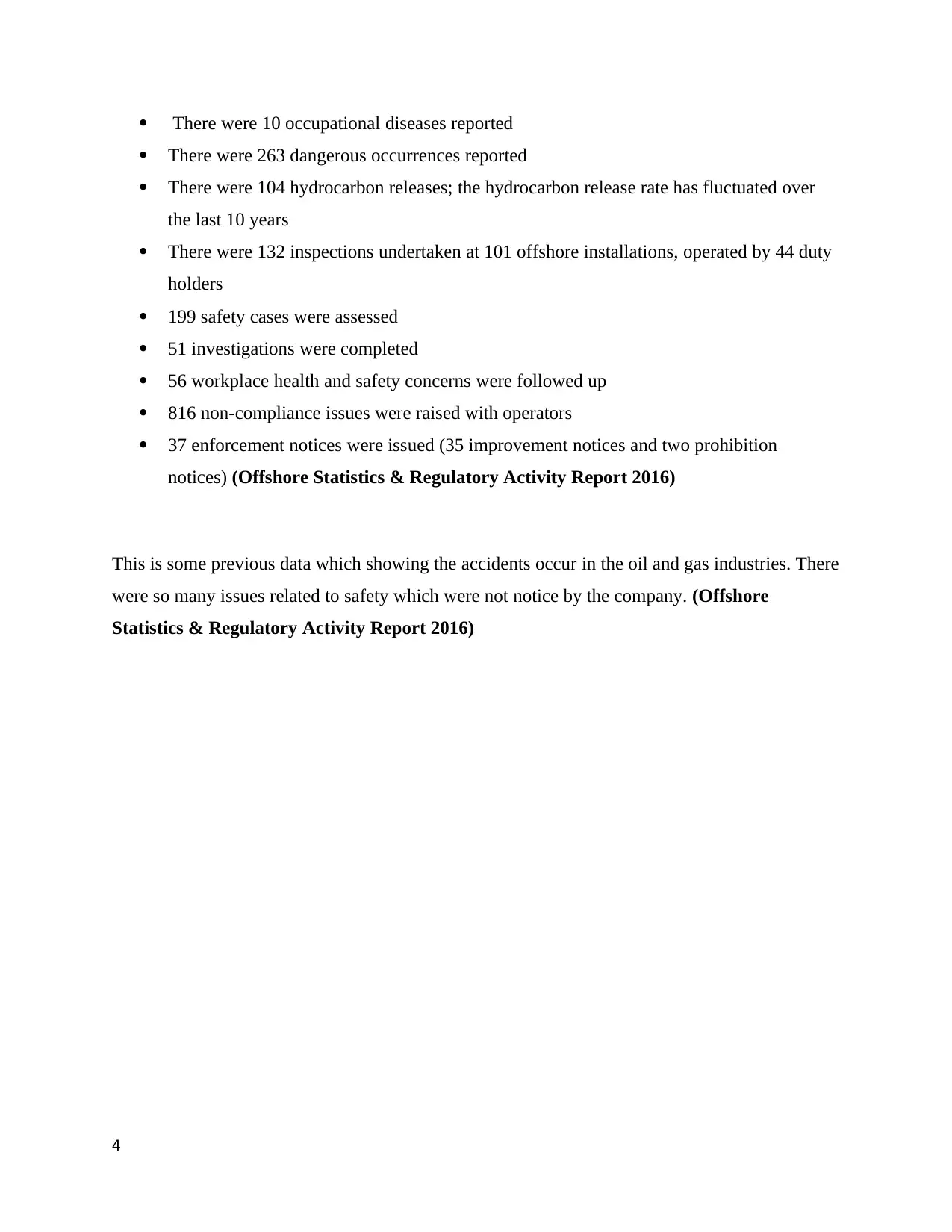
There were 10 occupational diseases reported
There were 263 dangerous occurrences reported
There were 104 hydrocarbon releases; the hydrocarbon release rate has fluctuated over
the last 10 years
There were 132 inspections undertaken at 101 offshore installations, operated by 44 duty
holders
199 safety cases were assessed
51 investigations were completed
56 workplace health and safety concerns were followed up
816 non-compliance issues were raised with operators
37 enforcement notices were issued (35 improvement notices and two prohibition
notices) (Offshore Statistics & Regulatory Activity Report 2016)
This is some previous data which showing the accidents occur in the oil and gas industries. There
were so many issues related to safety which were not notice by the company. (Offshore
Statistics & Regulatory Activity Report 2016)
4
There were 263 dangerous occurrences reported
There were 104 hydrocarbon releases; the hydrocarbon release rate has fluctuated over
the last 10 years
There were 132 inspections undertaken at 101 offshore installations, operated by 44 duty
holders
199 safety cases were assessed
51 investigations were completed
56 workplace health and safety concerns were followed up
816 non-compliance issues were raised with operators
37 enforcement notices were issued (35 improvement notices and two prohibition
notices) (Offshore Statistics & Regulatory Activity Report 2016)
This is some previous data which showing the accidents occur in the oil and gas industries. There
were so many issues related to safety which were not notice by the company. (Offshore
Statistics & Regulatory Activity Report 2016)
4
Paraphrase This Document
Need a fresh take? Get an instant paraphrase of this document with our AI Paraphraser
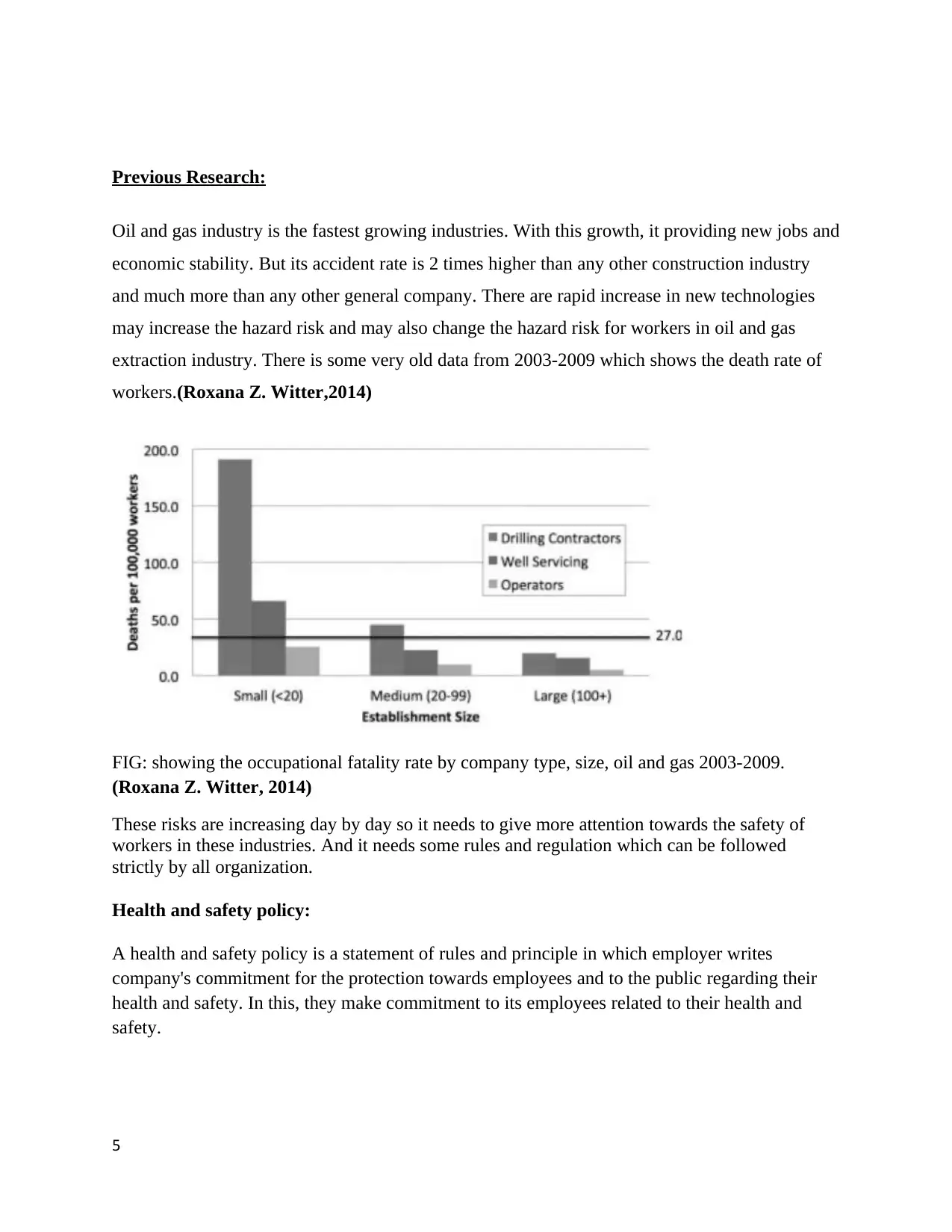
Previous Research:
Oil and gas industry is the fastest growing industries. With this growth, it providing new jobs and
economic stability. But its accident rate is 2 times higher than any other construction industry
and much more than any other general company. There are rapid increase in new technologies
may increase the hazard risk and may also change the hazard risk for workers in oil and gas
extraction industry. There is some very old data from 2003-2009 which shows the death rate of
workers.(Roxana Z. Witter,2014)
FIG: showing the occupational fatality rate by company type, size, oil and gas 2003-2009.
(Roxana Z. Witter, 2014)
These risks are increasing day by day so it needs to give more attention towards the safety of
workers in these industries. And it needs some rules and regulation which can be followed
strictly by all organization.
Health and safety policy:
A health and safety policy is a statement of rules and principle in which employer writes
company's commitment for the protection towards employees and to the public regarding their
health and safety. In this, they make commitment to its employees related to their health and
safety.
5
Oil and gas industry is the fastest growing industries. With this growth, it providing new jobs and
economic stability. But its accident rate is 2 times higher than any other construction industry
and much more than any other general company. There are rapid increase in new technologies
may increase the hazard risk and may also change the hazard risk for workers in oil and gas
extraction industry. There is some very old data from 2003-2009 which shows the death rate of
workers.(Roxana Z. Witter,2014)
FIG: showing the occupational fatality rate by company type, size, oil and gas 2003-2009.
(Roxana Z. Witter, 2014)
These risks are increasing day by day so it needs to give more attention towards the safety of
workers in these industries. And it needs some rules and regulation which can be followed
strictly by all organization.
Health and safety policy:
A health and safety policy is a statement of rules and principle in which employer writes
company's commitment for the protection towards employees and to the public regarding their
health and safety. In this, they make commitment to its employees related to their health and
safety.
5

A health and safety policy is a program which contains elements of an organization and
objectives of this are to make them possible to achieve its goal regarding the protection of all in
an organization. (Service NL, Newfoundland Labrador Canada)
These policies basically develop a work environment in an organization and can contribute to
improved occupational safety performance in an organization. Poor implementation of the latter
can easily result in Increased Risk of ill Health, Injury, Death, Loss of Reputation, Legal
Repercussions namely.
Explaining first of all about the health and safety hazards in oil and gas industry for which we
have the need to implement the policies in most effective manner and following them in order.
(Service NL, Newfoundland Labrador Canada)
POLICIES:
Policies are the some guidelines and can be in written or unwritten form which are adopt by any
organization to overcome from any issues and situations. These are normally based on both by
logic and by people's perception about what they seeing their surround (organization), including:
(CommunityToolBox, Changing Policies: An Overview)
There are some assumptions as follows:
● about the way of things to be done:These are come from those values and combination
of those values which they learn as children, what "everyone knows", and cultural
factors, local custom, religion, and some "common sense”. (CommunityToolBox,
Changing Policies: An Overview)
● what work to be done. This gives ideas about how to face a specific issue. It also see
the problems get solved strictly and get punished. It get funding for the uplifting of
program.
● about people thinking: people think about other groups of people in general or a
particular basis. There is sensitivity toward other cultures so it's gives a more idea to
deals with the situations. (CommunityToolBox, Changing Policies: An Overview)
Policy development procedure
This is the Policy Development Procedure should reflect :
1. type of policy should be contemplated;
2. importance of the policy at a particular issue; (safety hazard and health hazard)
3. number of people affected;
4. effect of that policy on the particular group people;
6
objectives of this are to make them possible to achieve its goal regarding the protection of all in
an organization. (Service NL, Newfoundland Labrador Canada)
These policies basically develop a work environment in an organization and can contribute to
improved occupational safety performance in an organization. Poor implementation of the latter
can easily result in Increased Risk of ill Health, Injury, Death, Loss of Reputation, Legal
Repercussions namely.
Explaining first of all about the health and safety hazards in oil and gas industry for which we
have the need to implement the policies in most effective manner and following them in order.
(Service NL, Newfoundland Labrador Canada)
POLICIES:
Policies are the some guidelines and can be in written or unwritten form which are adopt by any
organization to overcome from any issues and situations. These are normally based on both by
logic and by people's perception about what they seeing their surround (organization), including:
(CommunityToolBox, Changing Policies: An Overview)
There are some assumptions as follows:
● about the way of things to be done:These are come from those values and combination
of those values which they learn as children, what "everyone knows", and cultural
factors, local custom, religion, and some "common sense”. (CommunityToolBox,
Changing Policies: An Overview)
● what work to be done. This gives ideas about how to face a specific issue. It also see
the problems get solved strictly and get punished. It get funding for the uplifting of
program.
● about people thinking: people think about other groups of people in general or a
particular basis. There is sensitivity toward other cultures so it's gives a more idea to
deals with the situations. (CommunityToolBox, Changing Policies: An Overview)
Policy development procedure
This is the Policy Development Procedure should reflect :
1. type of policy should be contemplated;
2. importance of the policy at a particular issue; (safety hazard and health hazard)
3. number of people affected;
4. effect of that policy on the particular group people;
6
⊘ This is a preview!⊘
Do you want full access?
Subscribe today to unlock all pages.

Trusted by 1+ million students worldwide
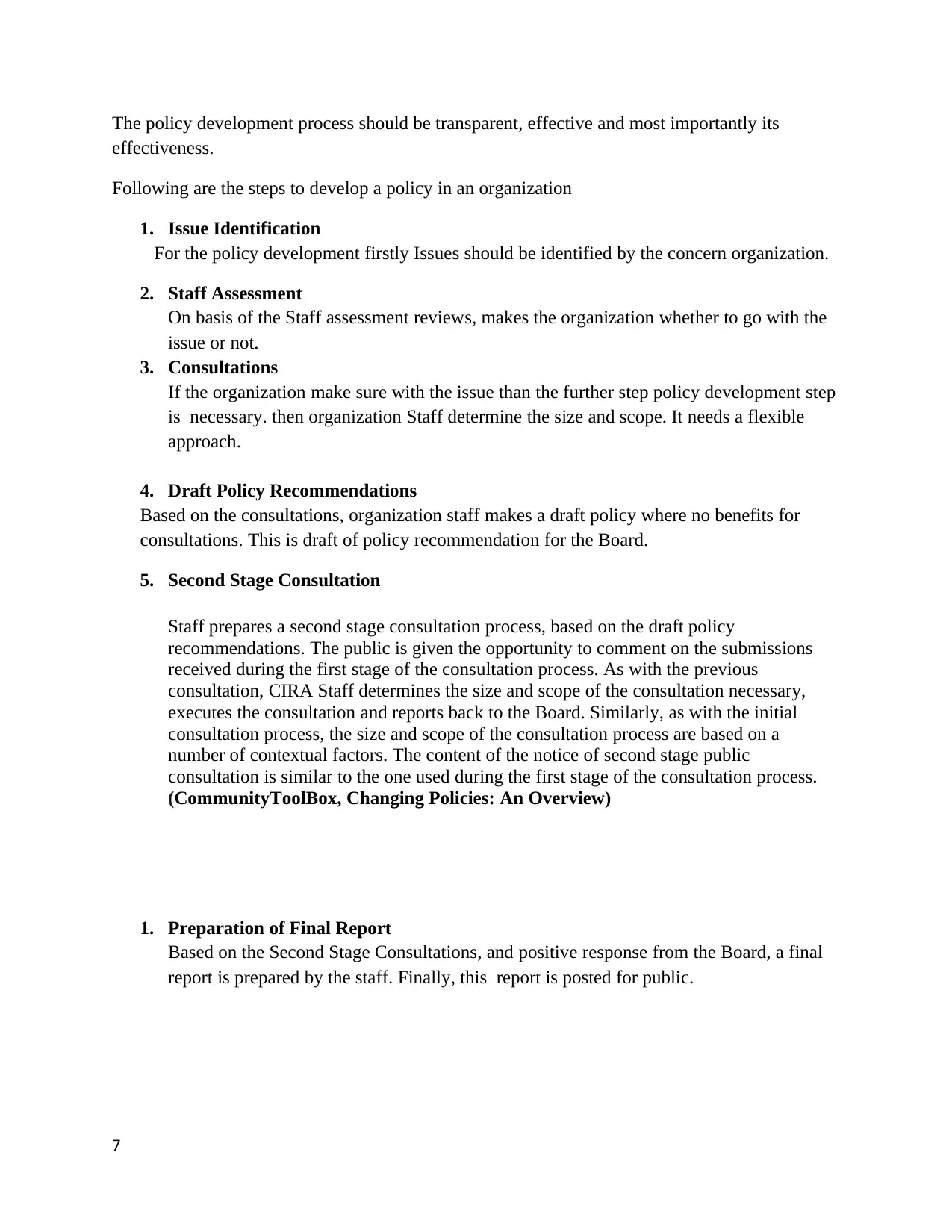
The policy development process should be transparent, effective and most importantly its
effectiveness.
Following are the steps to develop a policy in an organization
1. Issue Identification
For the policy development firstly Issues should be identified by the concern organization.
2. Staff Assessment
On basis of the Staff assessment reviews, makes the organization whether to go with the
issue or not.
3. Consultations
If the organization make sure with the issue than the further step policy development step
is necessary. then organization Staff determine the size and scope. It needs a flexible
approach.
4. Draft Policy Recommendations
Based on the consultations, organization staff makes a draft policy where no benefits for
consultations. This is draft of policy recommendation for the Board.
5. Second Stage Consultation
Staff prepares a second stage consultation process, based on the draft policy
recommendations. The public is given the opportunity to comment on the submissions
received during the first stage of the consultation process. As with the previous
consultation, CIRA Staff determines the size and scope of the consultation necessary,
executes the consultation and reports back to the Board. Similarly, as with the initial
consultation process, the size and scope of the consultation process are based on a
number of contextual factors. The content of the notice of second stage public
consultation is similar to the one used during the first stage of the consultation process.
(CommunityToolBox, Changing Policies: An Overview)
1. Preparation of Final Report
Based on the Second Stage Consultations, and positive response from the Board, a final
report is prepared by the staff. Finally, this report is posted for public.
7
effectiveness.
Following are the steps to develop a policy in an organization
1. Issue Identification
For the policy development firstly Issues should be identified by the concern organization.
2. Staff Assessment
On basis of the Staff assessment reviews, makes the organization whether to go with the
issue or not.
3. Consultations
If the organization make sure with the issue than the further step policy development step
is necessary. then organization Staff determine the size and scope. It needs a flexible
approach.
4. Draft Policy Recommendations
Based on the consultations, organization staff makes a draft policy where no benefits for
consultations. This is draft of policy recommendation for the Board.
5. Second Stage Consultation
Staff prepares a second stage consultation process, based on the draft policy
recommendations. The public is given the opportunity to comment on the submissions
received during the first stage of the consultation process. As with the previous
consultation, CIRA Staff determines the size and scope of the consultation necessary,
executes the consultation and reports back to the Board. Similarly, as with the initial
consultation process, the size and scope of the consultation process are based on a
number of contextual factors. The content of the notice of second stage public
consultation is similar to the one used during the first stage of the consultation process.
(CommunityToolBox, Changing Policies: An Overview)
1. Preparation of Final Report
Based on the Second Stage Consultations, and positive response from the Board, a final
report is prepared by the staff. Finally, this report is posted for public.
7
Paraphrase This Document
Need a fresh take? Get an instant paraphrase of this document with our AI Paraphraser
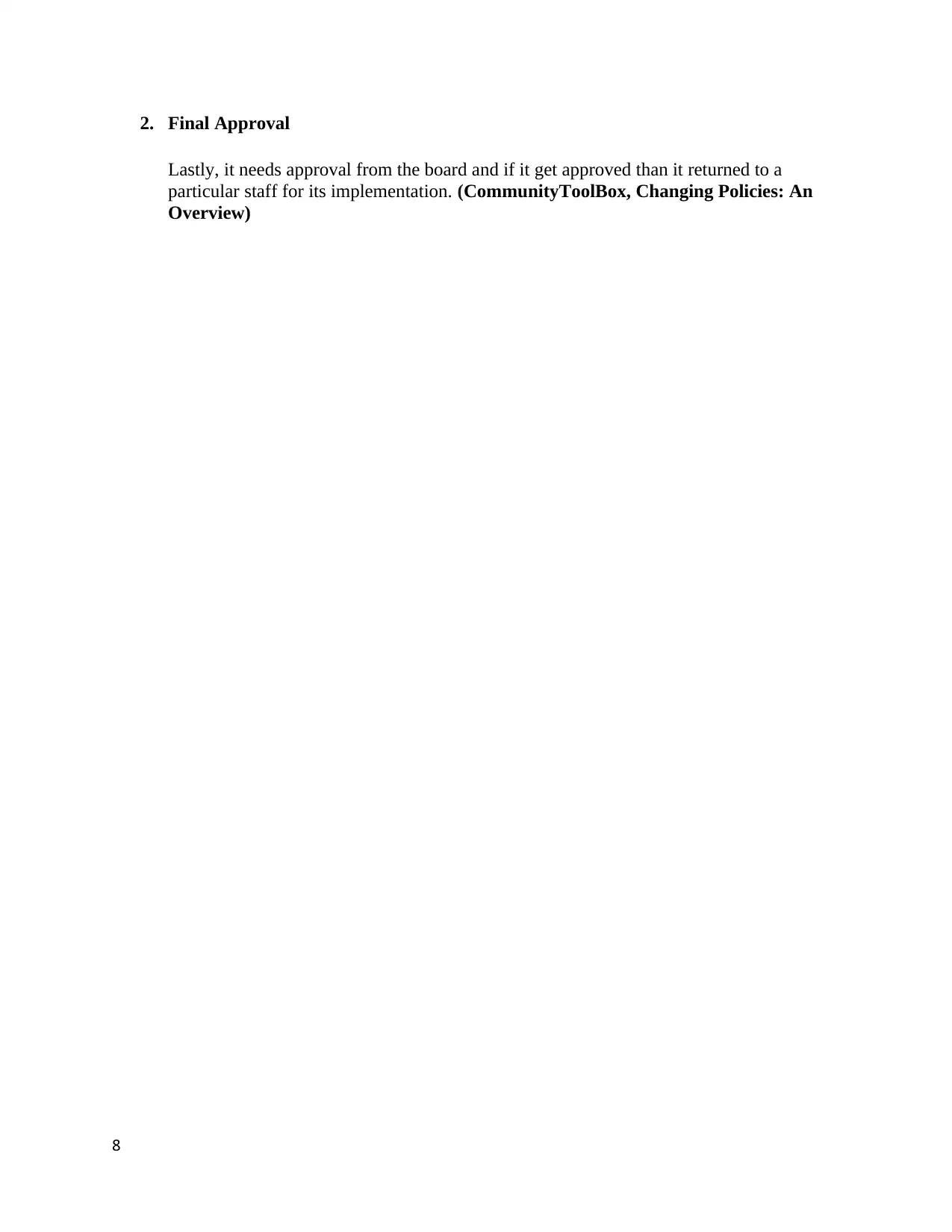
2. Final Approval
Lastly, it needs approval from the board and if it get approved than it returned to a
particular staff for its implementation. (CommunityToolBox, Changing Policies: An
Overview)
8
Lastly, it needs approval from the board and if it get approved than it returned to a
particular staff for its implementation. (CommunityToolBox, Changing Policies: An
Overview)
8
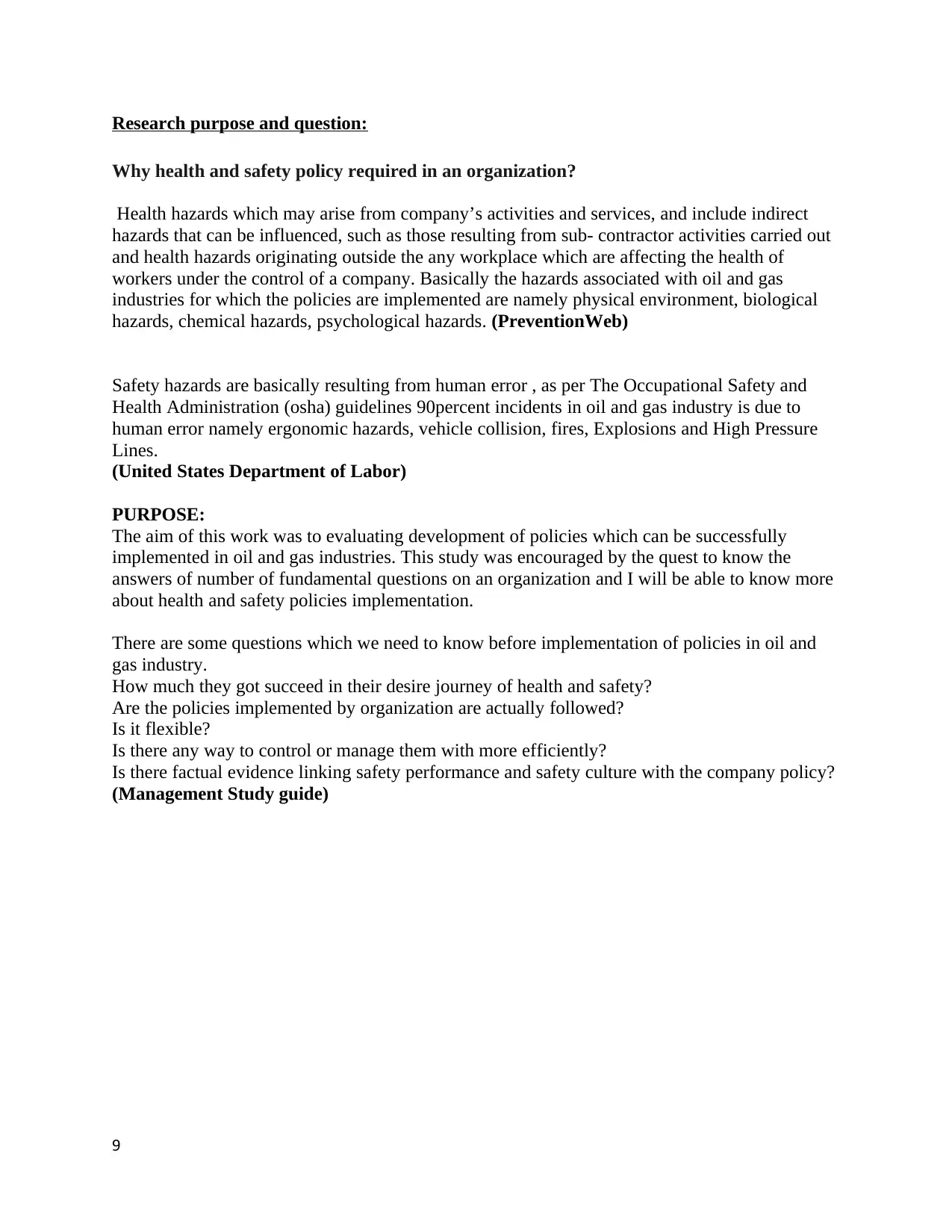
Research purpose and question:
Why health and safety policy required in an organization?
Health hazards which may arise from company’s activities and services, and include indirect
hazards that can be influenced, such as those resulting from sub- contractor activities carried out
and health hazards originating outside the any workplace which are affecting the health of
workers under the control of a company. Basically the hazards associated with oil and gas
industries for which the policies are implemented are namely physical environment, biological
hazards, chemical hazards, psychological hazards. (PreventionWeb)
Safety hazards are basically resulting from human error , as per The Occupational Safety and
Health Administration (osha) guidelines 90percent incidents in oil and gas industry is due to
human error namely ergonomic hazards, vehicle collision, fires, Explosions and High Pressure
Lines.
(United States Department of Labor)
PURPOSE:
The aim of this work was to evaluating development of policies which can be successfully
implemented in oil and gas industries. This study was encouraged by the quest to know the
answers of number of fundamental questions on an organization and I will be able to know more
about health and safety policies implementation.
There are some questions which we need to know before implementation of policies in oil and
gas industry.
How much they got succeed in their desire journey of health and safety?
Are the policies implemented by organization are actually followed?
Is it flexible?
Is there any way to control or manage them with more efficiently?
Is there factual evidence linking safety performance and safety culture with the company policy?
(Management Study guide)
9
Why health and safety policy required in an organization?
Health hazards which may arise from company’s activities and services, and include indirect
hazards that can be influenced, such as those resulting from sub- contractor activities carried out
and health hazards originating outside the any workplace which are affecting the health of
workers under the control of a company. Basically the hazards associated with oil and gas
industries for which the policies are implemented are namely physical environment, biological
hazards, chemical hazards, psychological hazards. (PreventionWeb)
Safety hazards are basically resulting from human error , as per The Occupational Safety and
Health Administration (osha) guidelines 90percent incidents in oil and gas industry is due to
human error namely ergonomic hazards, vehicle collision, fires, Explosions and High Pressure
Lines.
(United States Department of Labor)
PURPOSE:
The aim of this work was to evaluating development of policies which can be successfully
implemented in oil and gas industries. This study was encouraged by the quest to know the
answers of number of fundamental questions on an organization and I will be able to know more
about health and safety policies implementation.
There are some questions which we need to know before implementation of policies in oil and
gas industry.
How much they got succeed in their desire journey of health and safety?
Are the policies implemented by organization are actually followed?
Is it flexible?
Is there any way to control or manage them with more efficiently?
Is there factual evidence linking safety performance and safety culture with the company policy?
(Management Study guide)
9
⊘ This is a preview!⊘
Do you want full access?
Subscribe today to unlock all pages.

Trusted by 1+ million students worldwide
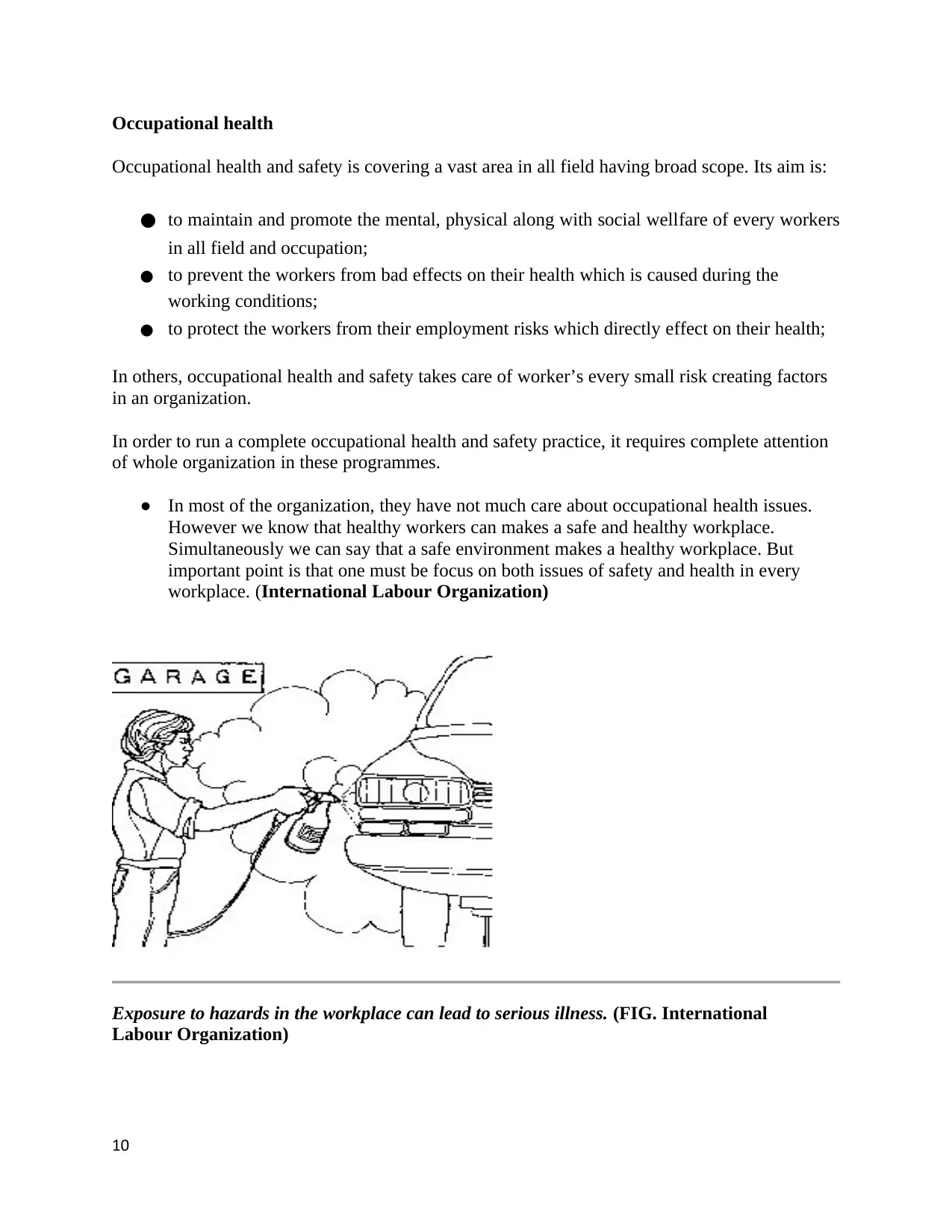
Occupational health
Occupational health and safety is covering a vast area in all field having broad scope. Its aim is:
● to maintain and promote the mental, physical along with social wellfare of every workers
in all field and occupation;
● to prevent the workers from bad effects on their health which is caused during the
working conditions;
● to protect the workers from their employment risks which directly effect on their health;
In others, occupational health and safety takes care of worker’s every small risk creating factors
in an organization.
In order to run a complete occupational health and safety practice, it requires complete attention
of whole organization in these programmes.
● In most of the organization, they have not much care about occupational health issues.
However we know that healthy workers can makes a safe and healthy workplace.
Simultaneously we can say that a safe environment makes a healthy workplace. But
important point is that one must be focus on both issues of safety and health in every
workplace. (International Labour Organization)
Exposure to hazards in the workplace can lead to serious illness. (FIG. International
Labour Organization)
10
Occupational health and safety is covering a vast area in all field having broad scope. Its aim is:
● to maintain and promote the mental, physical along with social wellfare of every workers
in all field and occupation;
● to prevent the workers from bad effects on their health which is caused during the
working conditions;
● to protect the workers from their employment risks which directly effect on their health;
In others, occupational health and safety takes care of worker’s every small risk creating factors
in an organization.
In order to run a complete occupational health and safety practice, it requires complete attention
of whole organization in these programmes.
● In most of the organization, they have not much care about occupational health issues.
However we know that healthy workers can makes a safe and healthy workplace.
Simultaneously we can say that a safe environment makes a healthy workplace. But
important point is that one must be focus on both issues of safety and health in every
workplace. (International Labour Organization)
Exposure to hazards in the workplace can lead to serious illness. (FIG. International
Labour Organization)
10
Paraphrase This Document
Need a fresh take? Get an instant paraphrase of this document with our AI Paraphraser

Need for the occupational health
Work is the key part of people’s lives because any workers spend seven to eight hours a day in
any organization which can be related to any department (steel, oil, gas, etc.).So it’s necessary to
provide and maintain a safe and healthy environment. Still many workers are not getting the
same situation.
Every day many workers are faced different health hazards all over the world. These are from
dust, noise, extreme temperature etc.
Figure 16.1 A multidisciplinary approach towards a sustainable and equitable development
(Occupational Health Services)
Some employers think little about responsibilities towards their workers' safety and health and
there are some employers even they don't know about their legal and moral responsibilities
towards their workers from hazards. Because of the hazards and less attention towards safety and
health, work-related accidents are very common in all over the world. So every organization
having the need of some safety and health policy so work-related accidents can be stopped.
(International Labour Organization)
11
Work is the key part of people’s lives because any workers spend seven to eight hours a day in
any organization which can be related to any department (steel, oil, gas, etc.).So it’s necessary to
provide and maintain a safe and healthy environment. Still many workers are not getting the
same situation.
Every day many workers are faced different health hazards all over the world. These are from
dust, noise, extreme temperature etc.
Figure 16.1 A multidisciplinary approach towards a sustainable and equitable development
(Occupational Health Services)
Some employers think little about responsibilities towards their workers' safety and health and
there are some employers even they don't know about their legal and moral responsibilities
towards their workers from hazards. Because of the hazards and less attention towards safety and
health, work-related accidents are very common in all over the world. So every organization
having the need of some safety and health policy so work-related accidents can be stopped.
(International Labour Organization)
11
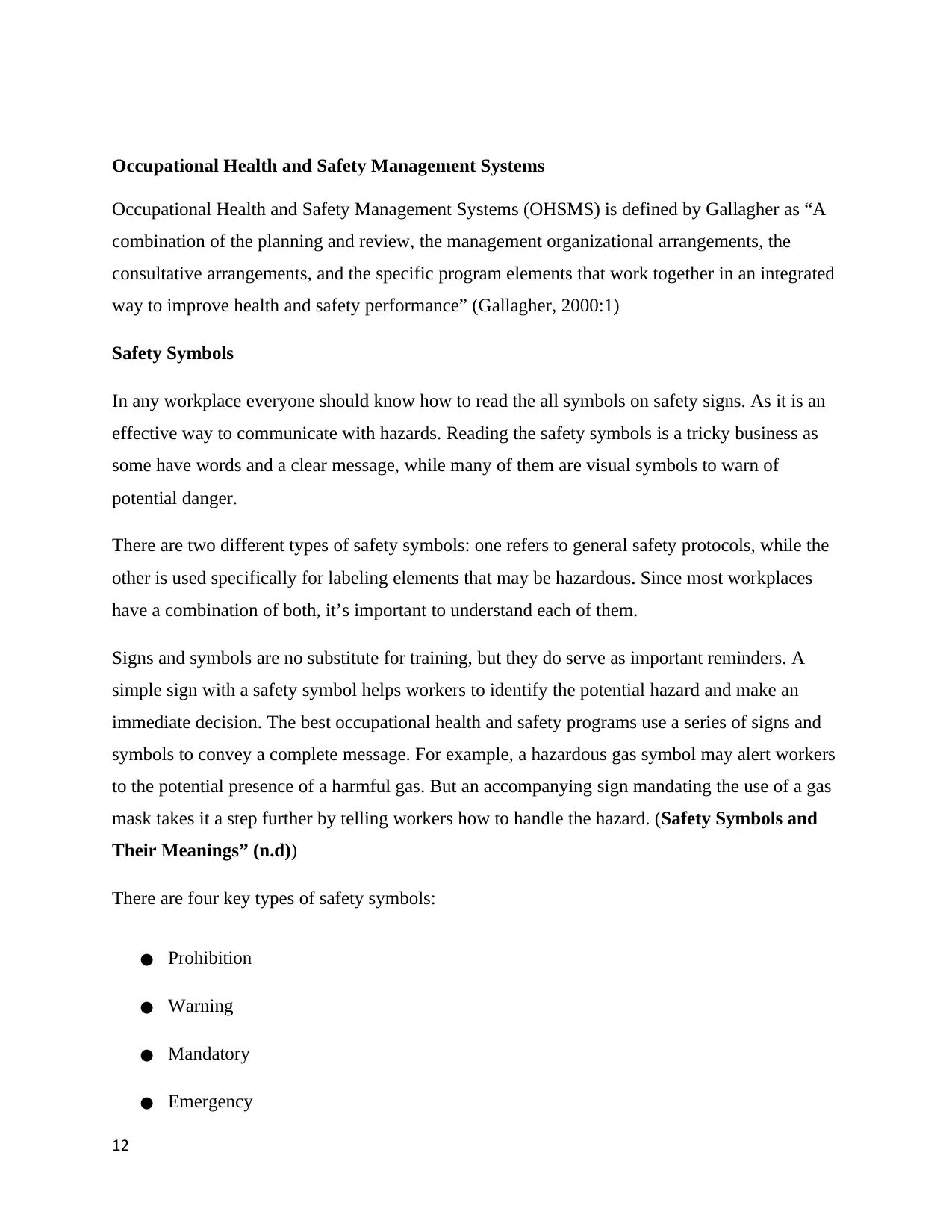
Occupational Health and Safety Management Systems
Occupational Health and Safety Management Systems (OHSMS) is defined by Gallagher as “A
combination of the planning and review, the management organizational arrangements, the
consultative arrangements, and the specific program elements that work together in an integrated
way to improve health and safety performance” (Gallagher, 2000:1)
Safety Symbols
In any workplace everyone should know how to read the all symbols on safety signs. As it is an
effective way to communicate with hazards. Reading the safety symbols is a tricky business as
some have words and a clear message, while many of them are visual symbols to warn of
potential danger.
There are two different types of safety symbols: one refers to general safety protocols, while the
other is used specifically for labeling elements that may be hazardous. Since most workplaces
have a combination of both, it’s important to understand each of them.
Signs and symbols are no substitute for training, but they do serve as important reminders. A
simple sign with a safety symbol helps workers to identify the potential hazard and make an
immediate decision. The best occupational health and safety programs use a series of signs and
symbols to convey a complete message. For example, a hazardous gas symbol may alert workers
to the potential presence of a harmful gas. But an accompanying sign mandating the use of a gas
mask takes it a step further by telling workers how to handle the hazard. (Safety Symbols and
Their Meanings” (n.d))
There are four key types of safety symbols:
● Prohibition
● Warning
● Mandatory
● Emergency
12
Occupational Health and Safety Management Systems (OHSMS) is defined by Gallagher as “A
combination of the planning and review, the management organizational arrangements, the
consultative arrangements, and the specific program elements that work together in an integrated
way to improve health and safety performance” (Gallagher, 2000:1)
Safety Symbols
In any workplace everyone should know how to read the all symbols on safety signs. As it is an
effective way to communicate with hazards. Reading the safety symbols is a tricky business as
some have words and a clear message, while many of them are visual symbols to warn of
potential danger.
There are two different types of safety symbols: one refers to general safety protocols, while the
other is used specifically for labeling elements that may be hazardous. Since most workplaces
have a combination of both, it’s important to understand each of them.
Signs and symbols are no substitute for training, but they do serve as important reminders. A
simple sign with a safety symbol helps workers to identify the potential hazard and make an
immediate decision. The best occupational health and safety programs use a series of signs and
symbols to convey a complete message. For example, a hazardous gas symbol may alert workers
to the potential presence of a harmful gas. But an accompanying sign mandating the use of a gas
mask takes it a step further by telling workers how to handle the hazard. (Safety Symbols and
Their Meanings” (n.d))
There are four key types of safety symbols:
● Prohibition
● Warning
● Mandatory
● Emergency
12
⊘ This is a preview!⊘
Do you want full access?
Subscribe today to unlock all pages.

Trusted by 1+ million students worldwide
1 out of 37
Related Documents
Your All-in-One AI-Powered Toolkit for Academic Success.
+13062052269
info@desklib.com
Available 24*7 on WhatsApp / Email
![[object Object]](/_next/static/media/star-bottom.7253800d.svg)
Unlock your academic potential
Copyright © 2020–2025 A2Z Services. All Rights Reserved. Developed and managed by ZUCOL.




